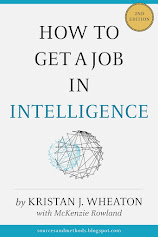"The most telling result of the research is the clear implication that intelligence analysis is conceptually driven as opposed to data driven. What is critical is not just the data collected, but also what is added to those data in interpreting them via conceptual models in the analyst's store of knowledge."
In other words, how you think is more important than what you know. This is one of the big take-aways from Philip Tetlock's wonderful Expert Political Judgment and you would be forgiven if you thought I was just touting his 2005 book again.
No, the quote above is from a 1979(!) INSCOM sponsored study into cognitive processes in intelligence analysis (called, amazingly enough, Cognitive Processes In Intelligence Analysis: A Descriptive Model And Review Of The Literature. It, and its companion piece, Human Processes In Intelligence Analysis: Phase 1 Overview are available through DTIC or you can download them here and here from Scribd. I wish I could say that I found them on my own but they come to me courtesy of Dalene Duvenage, who teaches intel analysis in South Africa, and the always useful IAFIE mailing list).
While much of the content in these two papers is probably more easily accessed by way of Dick Heuer's Psychology of Intelligence Analysis, there are some new gems here. One of my favorites is the reason for the studies.
According to Dr. Joseph Zeidner, Chief Psychologist for the US Army in 1979, and MG William Rolya, the Commander of INSCOM at that time, "Intelligence collection systems have proliferated over the past several years, increasing in complexity and in volume of output. However, there has been no corresponding improvement in the ability of intelligence personnel to analyze this flood of data." Sound familiar?
Another interesting tidbit comes from the Human Processes paper which lays out the personality attributes of the ideal analyst. These include:
- Is a technologist
- Is either a specialist or a generalist but not both
- Is an "information entrepreneur"
- Is comfortable with changing roles
- Can communicate (oral and written)
- Is a detective
- Is imaginative
- Is self-starting
- Has a profession (Intelligence analysis)
These criteria seem to strike a chord as well. All in all, both papers are worth a look, if only because they seem to prove that the more things change, the more they stay the same...






